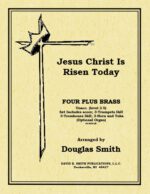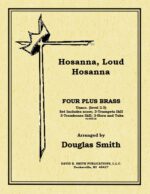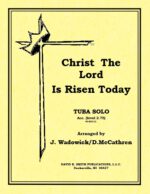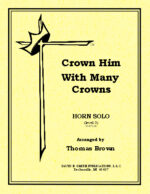-
-
-
-
Christ Arose
$12.00Scored for traditional brass quintet, an optional bartione part can be used to expand the piece to a sextet. After an opening upper brass fanfare, the lower parts present the theme in solemn fashion with further extended fanfares from the upper lines. The middle section reverses the stylistic assignments only to be given back to the opening styles. The with a powerful stacking of parts the piece concludes in a triumphant chord.
-
-
O Sacred Head, Now Wounded
$9.95Four Plus Brass Series- for two Trumpets and two Trombones (with opt. Horn and Tuba for color). Without any introduction the piece begins in four-part harmony and in a deeply reflective expression. As is the original, there are many meter changes. The second section is carried exclusively in the trombones until it is taken over by muted trumpets until consummated with harmonic divergence. The final section is established by the trumpets with subtle underpinning by the trombones. With one final strong presentation of the tune the piece concludes in repose- as one might expect.
-
Hymn To Joy (opt organ)
$9.95Four Plus Brass Series- for two Trumpets and two Trombones (with opt. Horn and Tuba for color). The introduction begins with an infectious motif which pictures a regal procession. The following section continues in the same flavor with new stately material, with a modulation the ensemble presents an intermission. Then the piece goes back to the material of the beginning. The next section becomes more harmonically diverse and builds more tension leading to a modulation where the song’s theme is presented in the trombones, then the trumpets. Coming to the Coda section an optional organ (and even congregation) gives a stately rendition of the famous “Hymn To Joy.”
-
Jesus Christ Is Risen Today
$9.95Four Plus Brass Series- for two Trumpets and two Trombones (with opt. Horn and Tuba for color). Beginning in a vigorous manner the introduction establishes jubilation leading up to the first statement of the theme in the trumpets echoed by the trombones. This exchange of motives continues throughout the whole first section until a rallentando presents the theme once again in a slower more expressive manner. This all leads up to the end where the style is broader and conclusive.
-
Hosanna, Loud Hosanna
$9.95Four Plus Brass Series- for two Trumpets and two Trombones (with opt. Horn and Tuba for color). Beginning in a robust and jubilant manner with unison statements in the voices. The trombones carry the tune with brief flourishes of punctuation in the trumpets. Then breaking into a duet in the trumpet and trombone in an imitative fabric, the piece gives over to the trumpets carrying the theme. The next section is slower and more harmonically divergent. Then once again a more vigorous manner like the beginning where the piece concludes with optional endings.
-
-
Jesus Paid It All
$7.00A brass quartet scored for two trumpets and two trombones with optional horn and baritone parts. The piece is in some ways simplistic and at the same time quite profound. The first section is somewhat gentle with subtle countrapuntal movement. The second section is more declamatory and then comes to a quiet repose.
-
Christ The Lord Is Risen Today
$9.00This is a brass trio with piano accompaniment. The brass scoring is for trumpet, horn or flugel horn, and trombone or baritone. The style is presented in a majestic manner first in block harmonies and then in a hocket structure. After a florid manner the piece follows a somewhat straight forward manner using fanfare motives in the upper parts the motion becomes more imitative. The final section is quite imitative and uses an overlayering of parts producing enjoyable passing around of the tune in a contrapuntal manner. With a final fanfare the piece concludes.
-
In The Garden
$8.00A brass trio for trumpet, horn and trombone with optional parts for trumpet and baritone. A somewhat straightforward piece from the standpoint of melody but it has a constantly evolving sense of texture. It’s as if a person were walking through a garden and reflecting on the surroundings and the implications of what they mean.
-
Are You Washed In The Blood?
$5.00This piece is scored for trumpet, trombone, and piano with optional horn and baritone parts. The piece is presented in a vigorous manner with the melodic material passed back and forth between the duet parts.
-
The Cross Of Jesus
$6.00A tuba solo which begins with a sense of agony in the piano using the tune of “Beneath The Cross Of Jesus.” The solo then makes a declamatory statement and then becomes very expressive in a recitative-like section. This section is expressive and then becoming more vigorous using thematic material from “At The Cross.” After another transition the piece become vibrant using the theme of “The Cross Is Not Greater than His Grace.” A swift modulation and a faster tempo the piece ramps up a vigorous flair where it elevates to a strong crescendo including some triple tongue motives.
-
Christ The Lord Is Risen
$5.50A brass solo in a Theme and Variation form. It starts out with a joyous introduction and then breaks into an antiphonal set of response of the tune. The first variation is essentially a descant while the piano carries the tune. The second variation is more contrapuntal in the piano while the solo carries on a fanfare-like obbligato. After a brief transition the piece concludes with a bold statement of the tune while being under-pinned with a walking bass line.
-
The Old Rugged Cross
$4.50Opening with a tender, contemplative statement, the embellished medley of this solo presents itself only to soar with a meaningful obbligato line, and then settle back into a sense of assurance that this grand old hymn exemplifies.
-
Hallelujah! What A Saviour!
$3.50This solo with piano follows a simple theme and variation form. It gives the young soloist the opportunity to play many styles in a short framework.
-
O Sacred Head
$5.00This quartet is in a solemn legato style throughout featuring melodic materials in each of the four parts. It is graced with gently moving accompaniment lines that further enhances the reflective spirit which is so evident in this hymn. It peaks in different portions of the composition and then reflects itself in a quiet repose to end.
-
The Cross Of Jesus
$6.00A trombone solo which begins with a sense of agony in the piano using the tune of “Beneath The Cross Of Jesus.” The solo then makes a declamatory statement and then becomes very expressive in a recitative-like section. This section is expressive and then becoming more vigorous using thematic material froA trombonet solo which begins with a sense of agony in the piano using the tune of “Beneath The Cross Of Jesus.” The solo then makes a declamatory statement and then becomes very expressive in a recitative-like section. This section is expressive and then becoming more vigorous using thematic material from “At The Cross.” After another transition the piece become vibrant using the theme of “The Cross Is Not Greater than His Grace.” A swift modulation and a faster tempo the piece ramps up a vigorous flair where it elevates to a strong crescendo including some triple tongue motives.m “At The Cross.” After another transition the piece become vibrant using the theme of “The Cross Is Not Greater than His Grace.” A swift modulation and a faster tempo the piece ramps up a vigorous flair where it elevates to a strong crescendo including some triple tongue motives.
-
Christ The Lord Is Risen
$5.50A brass solo in a Theme and Variation form. It starts out with a joyous introduction and then breaks into an antiphonal set of response of the tune. The first variation is essentially a descant while the piano carries the tune. The second variation is more contrapuntal in the piano while the solo carries on a fanfare-like obbligato. After a brief transition the piece concludes with a bold statement of the tune while being under-pinned with a walking bass line.
-
The Old Rugged Cross
$4.50Opening with a tender, contemplative statement, the embellished medley of this solo presents itself only to soar with a meaningful obbligato line, and then settle back into a sense of assurance that this grand old hymn exemplifies.
-
Hallelujah! What A Saviour!
$3.50This solo with piano follows a simple theme and variation form. It gives the young soloist the opportunity to play many styles in a short framework.
-
Hallelujah! What A Saviour
$9.00A horn quartet presented in a regal style with the horn parts in a stacked and blocked format puntcuated by the piano accompaniment. As the piece progresses the horn parts becoming more active with rhythmic motifs. The piece finishes much the way in began with a final declaration.
























